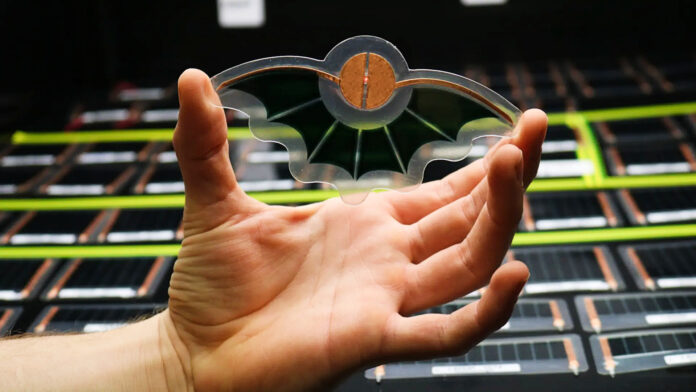France-based Dracula Technologies, developing energy-harvesting technology for low-power IoT solutions, has announced a new electrical energy storage solution, called LAYERVault, which retains photovoltaic power, drawn from light sources even in murky venues, on a single flexible film. It works with the firm’s existing LAYER solution, presented for marketing purposes as a bat-shaped photovoltaic printout that works at 200 lux, and even down to 100 lux.
The new LAYERVault technology was presented at CES in Las Vegas as a “first-of-its-kind”, which integrates electrical storage with low-light organic photovoltaic (OPV) energy harvesting. It is a “sustainable and cost-effective alternative to traditional batteries, enabling unprecedented energy-autonomy for IoT and ultra-low-power products”, the company said in a statement. It is a “significant milestone” for the IoT community, the company proclaimed.
It will simplify IoT design and reduce unit costs, it said. Dracula has already developed a LoRaWAN tracker that runs on its OPV solar cell that can be printed in any size, depending on the required power output, onto an 0.3mm adhesive sticker on a regular inkjet printer using special OPV ink. The LAYERVault addition brings real energy storage capability, alongside, it reckons. Check out the previous RCR post on its progress here, as well as on its ramp-up of production.
OPV technology draws power in the murkiest conditions, such as in warehouses or (“lights-out”) factories, where the luminous flux per unit area (lux), which measures illuminance, goes as low as 500. As a frame of reference, outdoor light registers at closer to 10,000 lux. The Dracula cell needs just a flash of murky light (“as low as one lux, right – which is almost completely dark,” the company has said previously of its LoRaWAN tracker unit) to wake up and send out a signal.
At CES, the company said the new LAYERVault solution offers an “unlimited 100-percent energy supply and storage based on organic materials without using rare earths or toxic materials”. It stated: “The energy storage layer… complements Dracula’s existing OPV harvesting product line, transforming it into a two-in-one product. The OPV LAYER harvests ambient light for low-power devices, while the energy storage layer ensures autonomy by storing energy for power consumption during periods without ambient light.”
Dracula is targeting IoT developers making solutions for electronic shelf labels (ESL), remote controls, indoor industrial IoT, and smart asset tracking, as well as indoor consumer IoT.
Brice Cruchon, chief executive and founder at Dracula, said: “We’re dedicated to revolutionizing battery-based electronics with a 100-percent sustainable energy source. LAYERVault provides a genuine solution for eco-friendly energy autonomy, already proving its worth in IoT deployments where eliminating batteries is crucial for large-scale success. With our new Green MicroPower Factory, the largest in Europe, a fully automated facility equipped with inkjet printing technology, we are set to produce up to 150 million cm² of OPV devices annually and positioned to serve high-volume IoT customers.”
Robert Comanescu, senior director for marketing and applications at LoRa-owner Semtech, commented: “With this breakthrough, fitting perfectly the low power intrinsic key customer benefit of LoRa technology, we are very keen to see the birth of innovative IoT products and solutions combining LAYERVault from Dracula Technologies and the wireless connectivity chips supplied by Semtech, enabling a smarter, more connected and more sustainable planet.”

